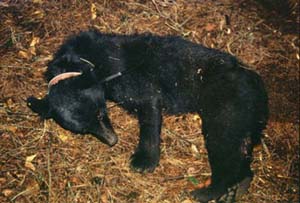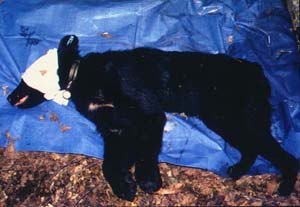There are ways to conduct survey on wild animals.
Tracing evidences of animal habitation, for example, is one way. What we
wish to present here is based on live capture. Obviously, this causes no
deaths. Anesthesia is applied on the spot. The captured bear is released
once information is gathered. (This process requires
permission from the Agency of Environment.) This type
of capture is referred to as academic capture. More specifically, it involves
measuring the body size, blood sampling, collecting external parasites,
and at times sampling tissue as well as semen as needed. We attach a radio-wave
transmitter and/or an eartag to some bears. The information so-obtained
brings to light the bear's age, its health condition, sexual maturity,
genetic diversity, etc. Once accumulated, the information will expose locality-dependent
features of the
black bear.
| Year |
|
|
|
|
|
|
|
1998 | 1999 | 2000 | Total |
|
|
|
|
|
|
|
|
|
|
3 | 2 | 20 |
|
|
|
|
|
|
|
|
|
|
1 | 1 | 16 |
|
|
|
|
|
|
|
|
|
|
4 | 3 | 37 |
The above table shows the total number
of bears academically captured in Tokyo.
(It counts in repeatedly captured ones.)
Without the double count, total of 33 bears
have been captured and released.
 |
 |
| Photo: A female recovering from anesthesia
(42 kg, 8.5 y. old, 8/6/96, Okutama-machi) |
Photo: A female wearing an eartag and a radio-transmitting collar
(27.5 kg, 4.5 y. old, 9/17/96)
It is being confirmed that the majority of bears in Okutama are small such as this one. |